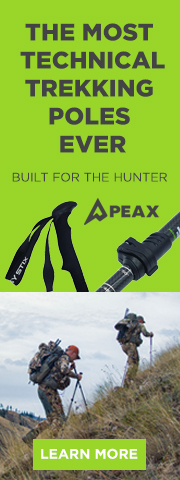I am new to elk hunting and am planning a elk hunt for this coming fall. Still haven't decided on a Unit yet but we are getting closer. My question is, once we have the Unit picked out, what are some tips to finding where elk will be in that Unit, by looking at maps? I know scouting is the best way in finding elk, but living 18-20 hours away, this is not possible. Any advice or tips would be great!
Navigation
Install the app
How to install the app on iOS
Follow along with the video below to see how to install our site as a web app on your home screen.
Note: This feature may not be available in some browsers.
More options
You are using an out of date browser. It may not display this or other websites correctly.
You should upgrade or use an alternative browser.
You should upgrade or use an alternative browser.
Finding elk on a map???
- Thread starter KYElk258
- Start date
I wouldn?t worry too much about not being there to scout as things change when the season rolls around. I can find them in July easy but only had 2 encounters during last season which was my first.
Use a lot of google earth/on X and CO atlas to find places you want to go see during season. If there isn?t any sign when you make it to those landmarks/areas then go to plan B. Have a lot of plans.
Also look for hard to get to areas. One of my encounters was less than 2 miles from a road but gained 1500ft in elevation in that time.
Sent from my iPhone using Tapatalk
Use a lot of google earth/on X and CO atlas to find places you want to go see during season. If there isn?t any sign when you make it to those landmarks/areas then go to plan B. Have a lot of plans.
Also look for hard to get to areas. One of my encounters was less than 2 miles from a road but gained 1500ft in elevation in that time.
Sent from my iPhone using Tapatalk
cohunter14
Administrator
- Jul 10, 2017
- 5,327
Welcome to the site KYElk! Another thing I'll throw out there to pay attention to is roads and trails in the area. The DOW atlas will show all of these on National Forest land. If you are hunting BLM instead, you will need to check their maps out. In my experience, the majority of hunting pressure is within a 1/2 mile of any road. Get outside of that, and you are going to separate yourself from a good majority of other hunters. Elk know this as well and for that reason, I've had more success finding elk in those areas. I'm not saying elk can't be found or killed closer to the road, but in general it's a good place to start.
Other things to look for are benches (flat areas on the side of a mountain) and pinch points like saddles in between two mountain tops or peaks that cause the elk to go through there instead of another more difficult route.
Another website to check out is http://www.toprut.com. You can download a bunch of layers for your specific GMU that can be viewed on Google Earth, which can be very helpful.
Other things to look for are benches (flat areas on the side of a mountain) and pinch points like saddles in between two mountain tops or peaks that cause the elk to go through there instead of another more difficult route.
Another website to check out is http://www.toprut.com. You can download a bunch of layers for your specific GMU that can be viewed on Google Earth, which can be very helpful.
cohunter14
Administrator
- Jul 10, 2017
- 5,327
big44a4 said:If there isn?t any sign when you make it to those landmarks/areas then go to plan B. Have a lot of plans.
Also look for hard to get to areas. One of my encounters was less than 2 miles from a road but gained 1500ft in elevation in that time.
We were posting at the same time, but these are two great points. I would have a bunch of different game plans. Start at Plan A and continue on until you find elk.
The 1/2 mile I spoke about can decrease quite a bit if you find a place that's difficult to access. There was a spot like this in a unit I hunted where you literally had to go no more than a few hundred yards from a major road and you could consistently get into elk. You just had to climb up a fairly steep hill that kept folks away.
It's already been said to have multiple points of interest, but I break them down into two categories.
I find my primary areas first. These are the areas I want to hunt if they are untouched, low pressured, and just scream to me as "elky areas".
Then I have my secondary options and these are areas I think the elk might be in if there is an army of hunters in my primary spots.
I find my primary areas first. These are the areas I want to hunt if they are untouched, low pressured, and just scream to me as "elky areas".
Then I have my secondary options and these are areas I think the elk might be in if there is an army of hunters in my primary spots.
Thank you all for the great information. I will start looking at these. I know I have a lot of work ahead of me but I am excited on working on it. We have a group of 5 guys that are all in great physical shape. Our plan, as of right now, is to pack in as far as we need to and set up camp for the week. Hoping to be as mobile as we can, depending on the location of elk in the area. We are planning on Archery hunting, possibly first week or two of season. Any and all help is greatly appreciated.
cohunter14
Administrator
- Jul 10, 2017
- 5,327
cnelk said:Sometimes you can even see them on GE
Found my first elk on google earth today. Pretty crazy!
I don't know if it's possible for you to post an image of the area you want to hunt without giving the area away but if you can post a topo or aerial photo of the area without an identifying marks I would be willing to look at it and tell you where I would start. I bet others would as well.
I only hunt my home state of Idaho so if the area you want to hunt isn't in North Idaho you can send photos of the area directly to me and I would take a look at them. I probably wont sell the GPS coordinates if they look promising. :-D
I only hunt my home state of Idaho so if the area you want to hunt isn't in North Idaho you can send photos of the area directly to me and I would take a look at them. I probably wont sell the GPS coordinates if they look promising. :-D
sn.outdoors
New member
- Jun 6, 2016
- 105
I've found elk on GE, hunted the area, and killed elk in the area twice. So literally finding elk is a very good start.cohunter14 said:cnelk said:Sometimes you can even see them on GE
Found my first elk on google earth today. Pretty crazy!

But yeah, as others have said, burn areas and thick North facing slopes are usually good elk habitat.
Sent from my XT1254 using Tapatalk
Another good research tool is reaching out to the USFS Regional HQ to check and see if they have any maps of particular sections.
My technique is as follows:
Obtain regional forest service map or other specific to the area. These are almost always in heavy detail and if you are able to read a topo map then you can get a good idea of what the landscape looks like. Take notes on drainages, creeks, peaks, streams, springs etc. Then kind of do a side by side to GE and refine the notes and locate them with a satellite view.
Then I compile my more specific notes and i'll make a call to a local FWP biologist for the unit and ask very specific pointed questions for the area. I would ask if a certain drainage habitation, where their count location for the elk in certain areas are, how the herds held up over winter, even asking about main food sources at particular elevations as affected by forest fires/old burns etc.
Then I look at human pressure and kind of mark each and every possible entrance on GE and figure out how far I have to get off the road. I usually look for the difficult point of entry. Usually where we necessarily dont want to venture in the Rocky Mountains they are found.
But thats just an idea to get you started. Besides boots on the ground a combination of compiling as much knowledge through eyes in the sky scouting and reaching out to as many as you can for the area.
My technique is as follows:
Obtain regional forest service map or other specific to the area. These are almost always in heavy detail and if you are able to read a topo map then you can get a good idea of what the landscape looks like. Take notes on drainages, creeks, peaks, streams, springs etc. Then kind of do a side by side to GE and refine the notes and locate them with a satellite view.
Then I compile my more specific notes and i'll make a call to a local FWP biologist for the unit and ask very specific pointed questions for the area. I would ask if a certain drainage habitation, where their count location for the elk in certain areas are, how the herds held up over winter, even asking about main food sources at particular elevations as affected by forest fires/old burns etc.
Then I look at human pressure and kind of mark each and every possible entrance on GE and figure out how far I have to get off the road. I usually look for the difficult point of entry. Usually where we necessarily dont want to venture in the Rocky Mountains they are found.
But thats just an idea to get you started. Besides boots on the ground a combination of compiling as much knowledge through eyes in the sky scouting and reaching out to as many as you can for the area.



